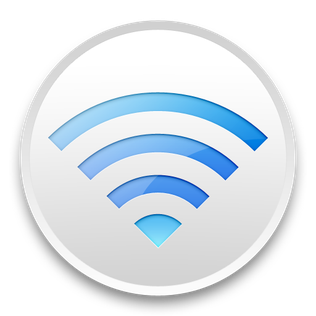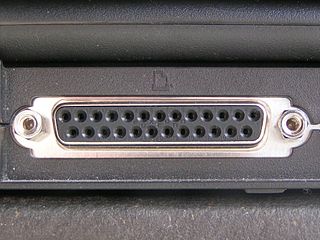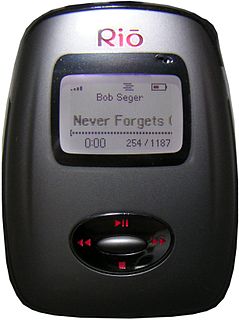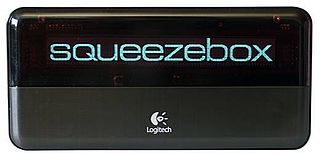
Universal Serial Bus (USB) is an industry standard that establishes specifications for cables, connectors and protocols for connection, communication and power supply (interfacing) between computers, peripherals and other computers. A broad variety of USB hardware exists, including 14 different connector types, of which USB-C is the most recent.

AirPort is the name given to a series of products by Apple Inc. using the Wi-Fi protocols. These products comprise a number of wireless routers and wireless cards. In Japan, the line of products was marketed under the brand AirMac due to previous registration by I-O Data.

In computing, a parallel port is a type of interface found on early computers for connecting peripherals. The name refers to the way the data is sent; parallel ports send multiple bits of data at once, as opposed to serial communication, in which bits are sent one at a time. To do this, parallel ports require multiple data lines in their cables and port connectors and tend to be larger than contemporary serial ports, which only require one data line.

The game port, originally introduced on the Game Control Adapter, is a device port that was found on IBM PC compatible and other computer systems throughout the 1980s and 1990s. It was the traditional connector for joystick input, and occasionally MIDI devices, until obsoleted by USB in the late 1990s.

The xD-Picture Card is an obsolete form of flash memory card, used in digital cameras made by Olympus and Fujifilm during the 2000s. The xD in the xD-Picture Card stands for eXtreme Digital.
IRIVER is a South Korean consumer electronics division owned by Dreamus which markets music and other accessories in its domestic market.

ZEN is a series of discontinued portable media players designed and manufactured by Creative Technology Limited. The players evolved from the NOMAD brand through the NOMAD Jukebox series of music players, with the first separate "ZEN" branded models released in 2004. The last Creative Zen player, X-Fi3, was released at the end of 2011.

A portable media player (PMP) or, digital audio player (DAP) is a portable consumer electronics device capable of storing and playing digital media such as audio, images, and video files. The data is typically stored on a compact disc (CD), Digital Video Disc (DVD), Blu-ray Disc (BD), flash memory, microdrive, or hard drive; most earlier PMPs used physical media, but modern players mostly use flash memory. In contrast, analogue portable audio players play music from non-digital media that use analogue signal storage, such as cassette tapes or vinyl records.
The PocketZip is a medium-capacity floppy disk storage system that was made by Iomega in 1999 that uses proprietary, small, very thin, 40 MB disks. Its relation to the original Zip drive and disk is the floppy medium and relatively much higher capacity than standard floppy disks. It was known as the "Clik!" drive until the click of death class action lawsuit regarding mass failures of Iomega's Zip drives. Thenceforth, it was renamed to PocketZip. A 100 MB Pocket Zip drive version had been in the works, was intended to be backwards compatible with the 40 MB disks, but ended up being vaporware and PocketZip itself would be discontinued as well.

The Rio Carbon is a line of digital audio players that was produced by the now defunct Rio from 2004 to 2005. It was similar in size, capacity, and cost with Apple's iPod Mini which debuted earlier the same year. This was Rio's second player to use a miniature hard disk for storage, after the Rio Nitrus, which was first to market with a 1.5 GB drive in late 2003.

Dreambox is a series of Linux-powered DVB satellite, terrestrial and cable digital television receivers, produced by German multimedia vendor Dream Multimedia.

Olympus m:robe was a product line of MP3 players that were produced by Olympus Corporation between 2004-2005. The name m:robe is a contraction of Music wardROBE. Olympus has ended production of the entire m:robe line. On October 13, 2004, Olympus released two MP3 players: the 5GB MR-100 with monochrome display and the 20GB MR-500i with colour display and built-in camera. The MR-100’s release price was $249.99 (USD), and the MR-500i’s release price was $499.99 (USD). The later MR-F10, MR-F20, and MR-F30 players with colour screens, drag-and-drop file transferring, and FM tuning and recording were only released in Asia.

Squeezebox is a family of network music players. The original device was the SliMP3, introduced in 2001 by Slim Devices. It had an Ethernet interface and played MP3 music files from a media server. The first Squeezebox was released two years later and was followed by several more models. Slim Devices was acquired by Logitech in 2006.

The Rio Forge is a digital audio player that was produced by Rio Audio, Inc. While it competed in the same market as Apple Inc's iPod mini, it is considerably different as it plays from internal memory, SD card, or FM broadcast and runs on a single AAA battery.

Netgear's Digital Entertainer line of products are digital media players that can pull multimedia content from home computers to the typical audio/video entertainment center. There are three products in the line, the EVA700, the HD EVA8000 and the current EVA9150 Digital Entertainer Elite. All support high definition video, the EVA700 via component output up to 1080i and the EVA8000/EVA9000 up to 1080p with both component and HDMI connectors. All models support audio, video, image and streaming audio and video formats and can be networked via wired and wireless Ethernet. The EVA700 is Intel Viiv certified.

The Archos AV series is a line of portable media players from the company called Archos that was released through 2003 to 2005. This series introduced the digital video recorder for the AV500, an optional feature that would be compatible in subsequent players. Although the AV series did not have standalone digital audio players, Archos did release them under the concurrently released Gmini series.
The Nokia 3600 slide is a mobile phone by Nokia that was released in August 2008. The phone runs the Series 40 3rd Edition platform. This is classed as the 'low end version' of the Nokia 6600 slide, its major difference being the lack of 3G support.

A dock connector is a connector used to attach a mobile electronic device simultaneously to multiple external resources. The dock connector will typically carry a variety of signals and power, through a single connector, to simplify the process of docking the mobile device. A dock connector may be embedded in a mechanical fixture used to support or align the mobile device or may be at the end of a cable.

HP Mini is a former line of small computers categorized as netbooks manufactured by Hewlett-Packard. They either contained a custom version of Ubuntu Linux, Microsoft Windows XP Home Edition or Windows 7 Starter operating system. Like most netbooks, they were not built with CD/DVD drives. However, HP did sell portable DVD-ROMs with HP's LightScribe disc imaging software. These netbooks are best used for written documents, small programs and web browsing. They can run standard software, but given their low price, they tend to have low end specifications, causing poor performance. They were announced from mid-2007, and marketed from 2008 through 2012.

IEEE 1394 is an interface standard for a serial bus for high-speed communications and isochronous real-time data transfer. It was developed in the late 1980s and early 1990s by Apple in cooperation with a number of companies, primarily Sony and Panasonic. Apple called the interface FireWire. It is also known by the brand names i.LINK (Sony), and Lynx.


















